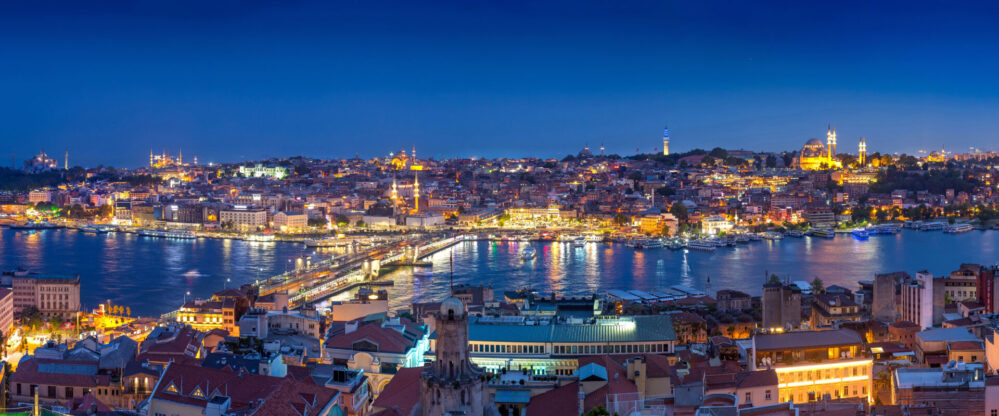SPECIAL CORRESPONDENT Eric Lucas traveled recently to Istanbul from Seattle. Nonstop on Turkish Airlines. This is his report.
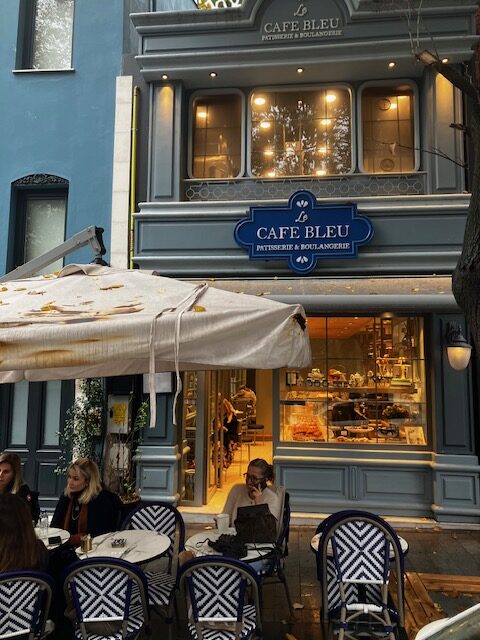
I’m having coffee in a quiet boulangerie on a sycamore-shaded cobblestone street. This is Le Café Bleu; fresh croissants glow amber in the pastry case; coffee machines glisten in stainless steel glory beside a mirror wall that perceptually widens the 3-meter footprint. Four wrought iron marble-top tables rest on black and white tiles. Thready chanson play on the sound system, perhaps Carla Bruni.
But my drink is Turkish coffee, dense and sweet.
Not only am I not in Paris, I’m not even in Europe.
I am in, however, Europe’s largest city. Twenty million people.
So where’s Waldo?
The neighborhood is Kuzguncuk and the address is Icadiye #34, and no, I cannot pronounce either, which lie on the broad shoulders of Anatolia sloping down to the Bosphorus strait, the narrow passage that cartographers long ago arbitrarily designated the boundary between Europe and Asia. Anatolia’s also known as Asia Minor, a Eurocentric moniker that reveals a lot about two millennia of Western attitudes.
I began the morning in Europe. Coffee and lunch in Asia “Minor.” Dinner back in Europe.
This odyssey is a geographic anomaly possible only in the world’s sole intercontinental metropolis, Istanbul.
If I sent a postcard by passenger pigeon westward to Europe it would take three minutes to get there—supremely faster than by car in the fearsome traffic over the two huge suspension bridges that span Istanbul’s Bosphorus. This city has been the capital of three great empires. Two great religions have faced off here. It holds the world’s greatest building and some of history’s most salacious legends.
Did Empress Eugenie sneak into Sultan Abdulaziz’s quarters at night in the 19th century Beylerbeyi Palace while her husband, Napoleon III, was imperiously unaware? The harem sultanas (senior imperial consorts) who pulled the puppet-strings of empire, were they medieval feminists? And the eunuchs who wound up marrying second-rank concubines… How did that work?
Makes The Bachelorette look like kindergarten.

In the heat of forbidden love, Abdulaziz and Eugenie need not have shed much sweat: Palace engineers, drawing on 14 centuries of Byzantine/Ottoman innovation, created a natural air conditioning system in which incoming breezes meet a massive interior fountain and are chilled enough to cool the 30-room building. Mind you, this is a modest summertime shack dwarfed by the city’s other two famous palaces, Topkapi (400 rooms) and Dolmabahce (320 rooms).
With all that historic magnificence, Istanbul’s people nurture a hope that perhaps now, after 17 centuries, the Western world will accord them the admiration long enjoyed by London, Paris, Rome and other capitals of civilization.
More foreign travelers come here than to any other city on Earth. Maybe they’ll pay attention now?
The last outpost of the Roman Empire for more than a thousand years, Constantinople was seized by the Ottoman Sultan Mehmed II in 1453. Although Suleiman the Magnificent’s campaign to overrun Europe ran aground in 1529 at the gates of Vienna, his empire dominated much of the Eurasian world for 500 years, and the icons of that time stand today as Istanbul’s most appealing attractions for visitors with visions of seraglio intrigue and Islamic mystery in their tourist psyches. Hundreds of harem members never left the three palaces you can tour; thousands of tourists ogle the opulent quarters and let their imaginations roam.
But none of this is just history. I ask Gizun, our voluble tour guide, if she can say which is her favorite sultan, and she immediately answers Mehmed… “And we know Suleiman as the Lawgiver, not the Magnificent,” she advises, intent on conveying the cultural sophistication of the Ottomans.
That was more than a half-millennium ago. Do you suppose an American tour guide could single out her hero from 1524?
Meanwhile, Gizun’s attempts to keep her hair covered by a shawl fail constantly inside the Suleymaniye Mosque (likewise for her assistant) and eventually I conclude it’s their own ambivalence rather than Newtonian gravity that keeps unmasking their heads. Is Turkiye an Islamic country? Well. Technically secular. But 99 percent of Turks are Muslim. But this is Istanbul. A capital of Europe.
Almost never do you see women in full head-to-toe face-veil abaya. You’ll see more in London’s Knightsbridge district. I watch Gizun carelessly fling her shawl back atop her head for the 20th time. A picture is worth a thousand words.
Not far away, the Hagia Sophia has withstood almost 1,500 years of human meddling in what I consider the world’s greatest building. A massive basilica dating to the early days of the Byzantine Empire (AD 537), it has been an Orthodox church, a Muslim mosque, then a monument open to all the world’s people by 1934 decree of Kemal Ataturk, founder of the Turkish Republic. For a thousand years it was Earth’s largest cathedral. Now it’s a fully dogmatized hall of religion again, converted back to a mosque in 2020 by Turkish President Recep Erdogan in a meretricious attempt to curry Islamic votes. It worked; he’s currently on his 27th term as president/nabob/boss-man.
No veils for Erdogan. His tailored suits look like fashion execs in Milan. Can he outlast his frenemy Putin? At least Erdogan keeps his shirt on. Istanbul votes against him every time.
But he’s the poobah, so secular tourists now may not visit the main hall of Hagia Sofia, confined instead to an interior gallery. Curtains cover up a priceless mosaic of Mother Mary and the Christ child, one of the world’s finest pieces of ancient art, placed inconveniently in the direction of Mecca, which is not one of the world’s great cities. Dogma wins again; Mother Mary is cloaked in an involuntary abaya.
But in Kuzguncuk, no abayas.
And throughout Istanbul, the most common English word you hear is… Europe.
Like most places, Turkiye claims distinctions that Istanbulites happily sing. The homeland of tulips. (No, actually it’s Kazakhstan.) What turquoise is named for. (Dubious.) The birthplace of yogurt…. Maybe but, whatever. The best baklava: Totally true.
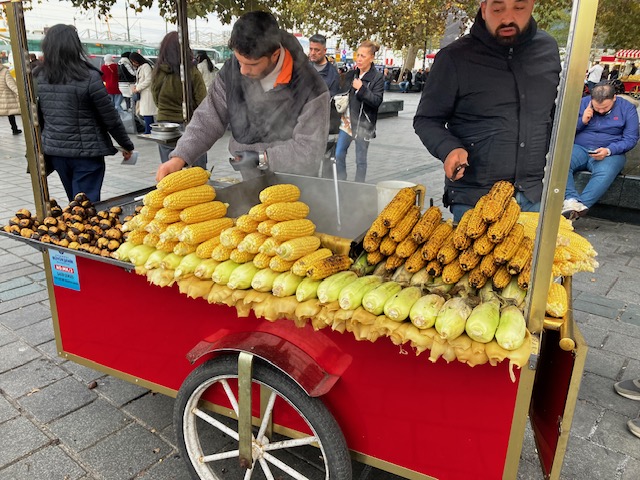

Touring a neighborhood which is claimed as the birthplace of the misnamed “Greek” yogurt, we pass a historic military school where Yasser Arafat and Moammar Khadafy were young cadets. Golly, swell. On the other hand, Lenin found sanctuary in London and Zurich, so there we are.
Today, having breakfast overlooking the Bosphorus, we see a half-dozen oil tankers an hour traversing this ultra-busy sea lane… False flag carriers hauling Russian oil out to the world, making Western sanctions a joke. Europeans fume; Turks shrug. This dynamic dates back centuries; World War I’s worst battle, Gallipoli, was fought for control of the Bosphorus. Brits still see it as a horrific disaster. Turks celebrate it as a great victory. Yesterdays’ news is today’s: This sea lane carries 12 percent of world maritime trade, including 2.4 million barrels of oil a day.
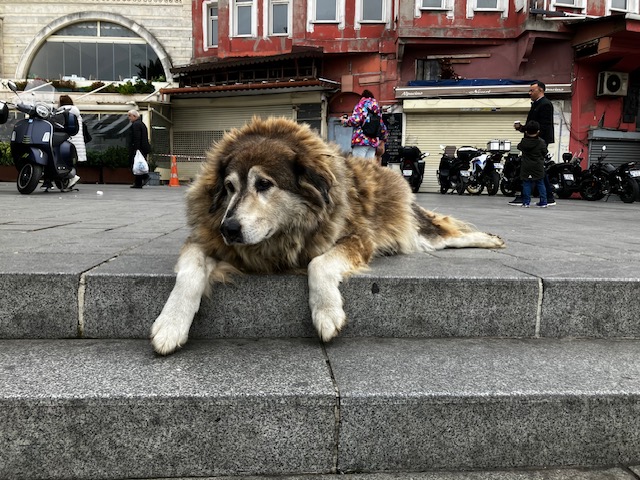
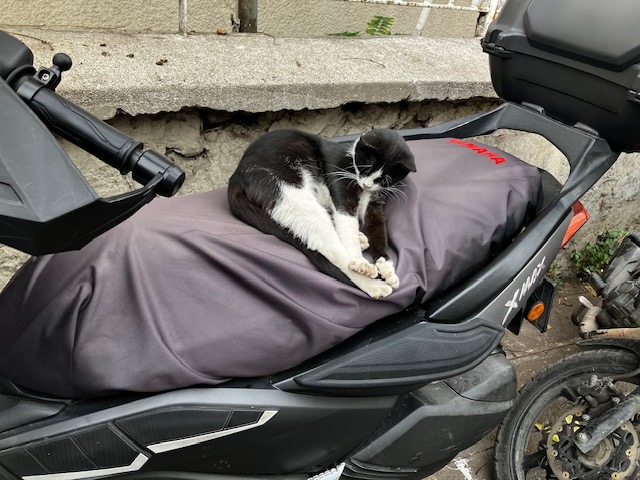
One of the world’s greatest cities, Istanbul is a vast waltz, to and fro in ¾ time, of contradictions that mirror 17 centuries of the human condition… never-ending perplexities. Like the mirror in Le Bleu, visitors here enter a prism within Aldous Huxley’s doors of perception.
One city, two continents, three great civilizations—that’s Istanbul’s history. Also its present, because even in our instant, traffic-choked Instagram age, in which bacteria outlive attention spans, Huxley’s admonition holds strong in a place where doorways are revered:
If the doors of perception were cleansed, everything would appear to man as it is, infinite.
Lifelong journalist and editor Eric Lucas lives on a small farm on an island north of Seattle, where he grows organic hay, garlic, apples, corn and beans. To sign up for Eric’s blog, email him at ericplucas@yahoo.com. Learn more at TrailNot4Sissies.com.
Share this Post

